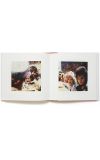
07 Oct 2013 04:08:48
As the current retrospective of his work at Media Space in London shows, the late Tony Ray-Jones was a pioneer of black-and-white documentary photography and his key subject matter was the English at leisure. His best known book, A Day Off: An English Journal was published in 1974, two years after his death from leukaemia, aged 30. It set the tone for at least two generations of British documentary work, wherein acute observation and multilayered, often metaphorical, narrative became the key determinants of photographs by the likes of Chris Killip, Graham Smith and Martin Parr. It is a surprise, then, to encounter this slim, but endlessly intriguing, book comprising Ray-Jones's previously unpublished early colour photography in which he turned his still developing gaze on America.
Ray-Jones pitched up in New York in 1961 on a scholarship to study graphic design at Yale and spent four years there, befriending the pioneering street photographer Joel Meyerowitz, whom he met at a processing lab. Together they walked the streets of the city, often photographing the same subjects, and shooting in colour at a time when it was regarded as vulgar by the photographic establishment. Colour film, though, was cheaper and could be developed faster in a commercial processing laboratory. "We were two young novices and we didn't know any better…" recalls Meyerowitz in an interview with the book's editor, Liz Jobey. "It's a youthful tactic like today's youth shoots digitally, so they can look at them while on the street. It's a matter of speed."
The results, now seen for the first time, are surprising. Ray-Jones's street photographs are not as kinetic or wilfully skewed compositionally as the work of his American contemporaries Meyorowitz or Gary Winogrand. Instead, he often lets his outsider's eye rest on people relaxing, conversing, reading or simply waiting amid the city's frenetic pulse. Time and again, he homes in on individual, often intimate, moments and isolates them as if looking for the quiet heart of urban America. Later, he called these images "isolated sketches" and retrospectively you can see what he means in relation to his later work, but there is something unique, and quite magical, about these colour studies, not least the richness of the tones: deep reds, dark greys and autumnal browns.
Here and there, too, there is a graphic designer's attention to form and geometry as in a fragment of the cityscape from above: all white lines, curves and angles with the roof of a yellow cab drawing the eye into the centre of the frame as if it has been placed there by an unseen hand.
Like the great Saul Leiter, Ray-Jones was experimenting with colour tones and composition at a time when monochrome had a monopoly on seriousness. But unlike most of the great pioneers of colour photography in the 1960s and early 70s – Leiter, Fred Herzog, William Christenberry, Stephen Shore, William Eggleston – he moved back to black and white. This may have had something to do with his return to England, which, in the mid-60s, was still a relatively monochrome place compared to America. Whatever the reason, his decision to abandon colour underpinned his greatness as a photographer of England and the English. Anyone interested in his evolution to greatness should investigate this surprising book of "isolated sketches", which have been deftly and cohesively selected by Jobey. A curious, illuminating look at a great photographer in the making.

